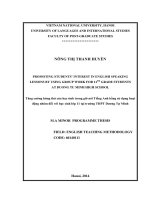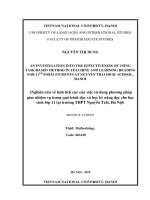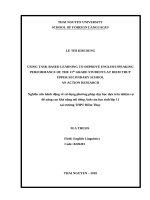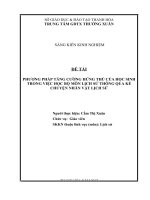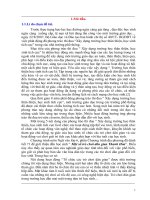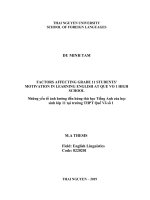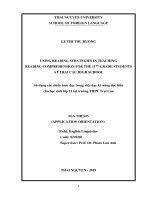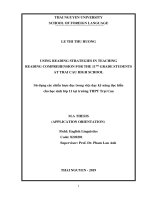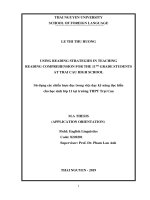Tăng cường hứng thú của học sinh trong giờ nói tiếng Anh bằng sử dụng hoạt động nhóm đối với học sinh lớp 11 tại trường THPT Dương Tự Minh
Bạn đang xem bản rút gọn của tài liệu. Xem và tải ngay bản đầy đủ của tài liệu tại đây (1.29 MB, 52 trang )
VIETNAM NATIONAL UNIVERSITY, HANOI
UNIVERSITY OF LANGUAGES AND INTERNATIONAL STUDIES
FACULTY OF POST-GRADUATE STUDIES
*********************
NÔNG THỊ THANH HUYỀN
PROMOTING STUDENTS’ INTEREST IN ENGLISH SPEAKING
LESSONS BY USING GROUP WORK FOR 11
TH
GRADE STUDENTS
AT DUONG TU MINH HIGH SCHOOL
Tăng cường hứng thú của học sinh trong giờ nói Tiếng Anh bằng sử dụng hoạt
động nhóm đối với học sinh lớp 11 tại trường THPT Dương Tự Minh
M.A MINOR PROGRAMME THESIS
FIELD: ENGLISH TEACHING METHODOLOGY
CODE: 60140111
Hanoi, 2014
VIETNAM NATIONAL UNIVERSITY, HANOI
UNIVERSITY OF LANGUAGES AND INTERNATIONAL STUDIES
FACULTY OF POST-GRADUATE STUDIES
*********************
NÔNG THỊ THANH HUYỀN
PROMOTING STUDENTS’ INTEREST IN ENGLISH SPEAKING
LESSONS BY USING GROUP WORK FOR 11
TH
GRADE STUDENTS
AT DUONG TU MINH HIGH SCHOOL
Tăng cường hứng thú của học sinh trong giờ nói Tiếng Anh bằng sử dụng hoạt
động nhóm đối với học sinh lớp 11 tại trường THPT Dương Tự Minh
M.A MINOR PROGRAMME THESIS
FIELD: ENGLISH TEACHING METHODOLOGY
CODE: 60140111
SUPERVISOR: HÀ CẨM TÂM, PhD.
Hanoi, 2014
i
DECLARATION
I certify that this thesis is entirely my own work. I have provided fully
documented references to the work of others. The material in this research
has not been submitted for assessment in any other formal course of study.
ii
ACKNOWLEDGEMENTS
I would like to express my deepest thanks to my supervisor Dr. Ha
Cam Tam for her generous assistance, enthusiastic guidance and constructive
supervision throughout my research. Dr. Ha Cam Tam‟s enlightening
suggestions and comments have shaped to a very large extent. Without her
help, this study would not have been completed.
I would also like to send my sincere thanks to all teachers at Post -
graduate Studies Department, ULIS – VNU who gave me interesting lessons
and comprehensive knowledge.
I am most thankful to students of class 11A4, Duong Tu Minh high
school for their enthusiastic participation in the study.
I am grateful to colleagues at Duong Tu Minh High School, my friends,
my classmates for their continued help and encouragement.
Last but not least, I would like to thank my husband, my parents who
always encourage me while the work was in process.
Ha Noi, August 2014
Nong Thi Thanh Huyen
iii
ABSTRACT
This thesis was carried out to investigate the benefits of using group
work in English speaking lessons and seek the answers to the hypothesis that
“Group work does promote students‟ interest in English speaking lessons to
students at 11
th
grade at Duong Tu Minh High School.” The researcher carried
out some group work activities on students to investigate whether group work
techniques promote students‟ interest. Observation method was used to find
the answer to the hypothesis. The findings of the research revealed that group
work was an effective teaching method that should be used in communicative
language teaching. The reason was that it strongly enhanced students‟ interest
in class activities. The students found working in groups interesting, which
made them participate more in the lesson. However, there were some
problems the teachers should take into consideration when conducting these
activities such as group size, the way of grouping, students‟ level of
proficiency, and so on. It is hoped that this thesis will help other teachers of
English be aware of the effectiveness of group work and apply it in their
teaching.
iv
TABLE OF CONTENS
DECLARATION i
ACKNOWLEDGEMENTS ii
ABSTRACT iii
TABLE OFCONTENT iv
Part A: INTRODUCTION 1
1.Rationale. 1
2. Aims of the study. 2
3. Scope of the study. 2
4. Hypothesis. 2
5. Methods of the study 2
6. Organization of the study. 3
Part B: DEVELOPMENT 5
Chapter 1: THEORETICAL BACKGROUND. 5
1.1The importance of teaching speaking skills. 5
1.2 Characteristics of a successful speaking lesson. 6
1.3. Learners’ interest in learning languages 7
1.3.1. Concept of interest 7
1.3.2.Factors affecting students’ interest 7
1.4. Group work. 9
1.4.1. Definition of group work. 9
1.4.2. Types of group work 10
1.4.3. Group work activities … 11
1.4.4. The benefits of teaching and learning speaking English
by group work 14
1.5. Organization of group work. 15
1.5.1. Preparation for group work 15
v
1.5.2. Steps of organizing group work 17
Chapter 2: METHODOLOGY 19
2.1. Hypothesis. 19
2.2. Setting of the study. 19
2.3. Participants of the study. 19
2.4. Data collection instruments. 19
2.5. Data collection procedure. 21
Chapter 3: DATA ANALYSIS AND DISCUSSION 25
3.1. Students’ participation. 25
3.2. “Learners talk a lot” 27
3.3. Students’ attitude in speaking lessons. 33
Part C: CONCLUSION
1. Major finding 36
2. Limitations of the study. 36
3. Recommendation for further study. 32
4.Implications 37
REFERENCES: …38
APPENDIXES I
1
PART A: INTRODUCTION
1. Rationale
English has become one of the most popular languages in the world
today. It is used widely in every field of society such as politics, business,
international conference, education and everyday communication. As a result,
teaching and learning English play an important role in the development of
the society. However, it cannot be denied that teaching and learning English
appear not to be really effective. Students have difficulty using English in
their work as well as in their daily life, which results in limitations in their
work.
To improve students‟ speaking skills, promoting their interests is really
important in teaching and learning. As we may know, teaching and learning
are complex activities; the quality and effectiveness belong to the learners,
and this also belongs to many factors such as awareness capacity, purposes of
study, determination and other objective factors such as learning atmosphere,
teachers and interests of the learners. Among them, student interests play an
important part in effectiveness of learning process. When students are
interested in learning, especially in speaking lessons, they will become more
active and learn more effectively. As a result, their speaking skills will
improve.
There are many ways to promote students‟ interest in English speaking
classes, among them, group work, key features of learner- centered
orientation- has received more emphasis because of a number of advantages it
brings about. Group work creates more opportunities for students to work
with each other by exchanging their ideas and, therefore, learning so many
things from their partners. Participating in group work makes students
confident and creative in learning English. Group work also helps students
2
overcome shyness and make students are more interested in English speaking
lessons as well as other English lessons.
Being a teacher of English at Duong Tu Minh High School, the
researcher is well aware of the importance of using group work to promote
students‟ interest in English speaking lessons. This led me to the choice of the
study “Promoting students’ interest in English Speaking lessons by using
group work” in the hope of finding the ways teachers organize group work to
promote students‟ interest in English lessons, especially in speaking lessons
so that we will achieve successfulness in teaching and learning. It is also
hoped that this study may offer the teachers of English at Duong Tu Minh
High School ways on how to use group work in teaching more effectively.
2. Aims of the study
The aim of the study is to investigate whether the use of group work in
English speaking lessons promotes students‟ interest and the difficulties that
teachers and students face with when conducting this technique.
3. Scope of the study
The study focuses on group work to promote students‟ interest in
English speaking lessons, especially group work that was appropriate to 11th
grade students in mountainous areas. Group work in this study was tested
with the participation of these students.
4. Hypothesis
This study was set up to test the following hypothesis: “Group work
helps promote students‟ interest in English speaking lessons.”
5. Methods of the study
Group work activities were designed and conducted on the students of
grade 11. Data was collected through group work implemented by the
students. Data was also collected by photos and notes taking.
3
6. Organization of the study
This study consists of three parts:
Part A, Introduction, presents rationale, aims, scope, hypothesis,
methods and design of the study.
Part B, Development, consists of three chapters.
Chapter 1 discusses the theoretical background relevant to issues of
the study. The first section presents teaching speaking skills in general, the
second section discusses the learners‟ interest in learning languages and the
last section is the discussion of group work activity.
Chapter 2 discusses the methodology of the study. In this chapter, the
hypothesis, data collection instrument and data collection procedure are
presented.
Chapter 3 presents data analysis and findings show the results of the
research. In this chapter, the author tried to find out the answers to the
hypothesis.
Part C, Conclusion, summarizes the key issues as well as the
limitations of the study and makes suggestions for further research.
4
PART B: DEVELOPMENT
Chapter 1: THEORETICAL BACKGROUND
In the beginning, this chapter will present some theoretical background
based on which the study will be carried out. The first section discusses the
speaking skill. The second section presents the students‟ interest and the
factors affecting their interest in speaking lessons. Then group work activities
in language teaching and learning are discussed in the third section.
1.1. The importance of teaching speaking skills
For many years, teaching speaking has been underestimated and English
teachers seem to teach speaking just as a repetition of drills or memorization
of dialogues.
Nowadays, the world requires that the goal of teaching speaking should
improve students‟ communicative skills so that students can express
themselves with their new language.
According to communicative language teaching, teaching speaking
skills involves the use of language through different communicative activities.
When using communicative activities in speaking, it is very important to
make sure that students feel comfortable and confident to participate in
learning activities. This makes students find it easy to discuss and share ideas
with their partners. Students should be given more chances to speak in class
so that they can attain mutual understanding and practice language.
Communicative activities offer opportunities to improve speaking skills
as well as cognitive ability. It is clear that successful communication is an
integrated accomplishment. When participating in communicative activities,
students will become more active; have opportunities to interact with other. In
brief, communication activities can boost proficiency and greatly improve
communicative competence.
5
There are various definitions of speaking and the popular acceptance
comes from Jones, R (1989: 86) who defines speaking as “Speaking is a form
of communication, so it is important that what you say conveyed in the most
effective way”. Chaney states that “ speaking is the process of building and
sharing meaning through the use of verbal and non- verbal symbols, in a
variety of context” (Chaney, 1998, p.13)
As for Ur(1996) , people who know a language are referred to as
“speakers” of that language as if speaking includes all others kinds of
knowing. Florez claims that speaking is “an interactive process of
constructing meaning that involves producing and receiving and processing
information. It is often spontaneous, open-ended, and evolving.” (Florez,
1999). To help students to become “speakers” of a new language, it is
important for language teachers to pay attention to teaching speaking skills
rather than leading students to memorization. The teacher should give their
students opportunities to practice language so that they can promote their
language.
Teaching speaking for students is very important because the goal of
teaching speaking skills is communicative efficiency. Students should be able
to make themselves understand what they said, using their current proficiency
to the fullest. They can try to avoid misunderstanding in the message due to
faulty pronunciation, grammar, or vocabulary, and to see the social and
cultural rules that apply in each communication situation.
In teaching English speaking, teachers may face many difficulties that
prevent them from a good conduction such as: number of learners, types of
learners, size of class, and types of materials. Therefore, the teachers must
6
have a variety of techniques and procedures through which are suitable for
students.
1.2. Characteristics of a successful speaking lesson
According to Ur (1996), there are four characteristics of a successful
speaking lesson. The first characteristic is “learners talk a lot”. This means
that the amount of learning in a speaking lesson is correlated with the
amount of talking by the learner. Thus, the more time learners engage
with in the course of a lesson, the more language they can obtain, so
learners speaking time makes a speaking lesson successfully.
The second characteristic that he mentions is “participation is even”.
He means that classroom discussion should not be dominated by a minority of
talkative participants. All students should have opportunities to speak, and
contributions are fairly evenly distributed. It is clearly that a successful
speaking lesson must provide opportunities of speaking to all learners with
different levels.
“Motivation is high” is the third characteristic of a successful speaking
activity. Learners are eager to speak because they are interested in the topic,
they find the topic is familiar and want to talk about it and they want to
contribute to achieve the task objective. The activities that teachers design
should make learners have a high motivation. Brown (1994) states that it is
when students‟ learning styles are matched with appropriate approaches in
teaching that their motivation, performances, and achievements will increase
and be enhanced. Nunan (1989) points out that accommodating learners‟
needs and preferences is vital in designing a learner-centered curriculum.
Understanding of students‟ preferred way of learning helps the teacher not
only to alter his or her teaching style but also to diversify classroom tasks or
activities to accommodate different learning style.
7
The last characteristic is “Language is of an acceptable level”. Ur means
that learners express themselves with suitable language, easily
comprehensible to each other. To help learners get success in speaking, the
teacher should choose the suitable topics for learners so that learners can
express their own ideas with their vocabulary, experience and knowledge.
Besides, the teacher should provide relevant information, vocabulary and
structures related to the topic before organizing the activity so that all learners
are willing to participate in speaking.
1.3. Learners’ interest in learning languages
1.3.1. Concept of interest
Ellis (1994) (cited in Keller, 1984) states that interest is one of the main
elements of motivation and a positive response to stimulate based on existing
cognitive structures in such a way that learners‟ curiosity is aroused and
sustained. In other words, interest shows learners‟ desire to learn the target
language. It can be seen that students who are given opportunities for
communication will be eager to talk to share information with others.
Ellis (cited in Dickinson, 1987) also points out that “interest is
engendered if learners become self-centered”. This means they are able to
determine their learning objectives, choose their own way of achieving these,
and evaluate their own progress. In this case, students have the desire to talk
or to ask for information. They want to know and try to talk it through to
achieve their goals.
1.3.2. Factors affecting students’ interest.
There have been some studies on the factors affecting students‟ interest
in learning a foreign language so far. Some factors such as language level,
learner level, learning situation level were stated by Dornyei (2001) and
8
internal and external factors stated by Williams and Burnden (1997).
Although researchers have had some different views in this issue, they all
have come to an agreement with a list of common factors affecting students‟
interest. These factors can be divided into three main factors: Students‟
motivation, teaching techniques of teachers and teachers‟ personalities.
Motivation is an important factor that leads to students‟ success in
learning in general, and in learning language in particular. And when students
have their own motivation they will have interests in learning. So what is
motivation?
According to Littlewood (1998), “motivation is a complex phenomenon and
includes many components: the individual‟s drive and need for achievement
and success, curiosity, desire for stimulation and new experience that make up
her motivation. In other words, motivation is both intrinsically and
extrinsically- originated.”
Intrinsic motivation is a type of motivation that plays an important role
in most learners‟ second language learning success. For many learners, the
purpose for learning a different language is the "interest in the culture and the
target language group" or the "positive attitudes towards the target language
group" while for some others it is the interest in learning tasks. Teaching
methods and learning activities can attract them, arouse and maintain their
interest in doing the tasks. In short, intrinsic motivation "Involves the arousal
and maintenance of curiosity and can ebb and flow as a result of such factors
as learners' particular interests and the extent to which they fell personality
involved in learning activities."
While Extrinsic motivation derives from the influence of some kinds of
outside indicators, including the influence of the teacher, the learner's desire
to please significant people or their wish to succeed in an external exam, or
9
peer group influence, which are different from the wish to learn for its own
sake or interest in learning tasks.
Teaching techniques of teachers is considered one of the main factors
that affect students‟ interest. According to the new methods of teaching, the
teachers no longer played the role of the knowledge provider and the students
were the passive knowledge receivers, the teaching techniques is really
important to guide students in their learning process and different teaching
techniques create different degrees of students‟ participation and interest in
the lesson.
The last factor that I would like to mention is teachers‟ personal
qualities. So as to draw students‟ attention and interest, teachers should make
students trust and feel comfortable when they participate in speaking lesson.
Barry (1993) points out some characteristics a teacher should have. The
necessary characteristics are being natural, being warm, being pleasant, and
being tolerant.
Being natural means the relationship between him and his students will
be closer, if the teacher behaves naturally, which promotes students‟ interest
in the lesson. Being warm is when the teacher considers students as his
friends. Students therefore will find it easy to express themselves in the
lesson. Being pleasant will make the classroom‟s climate comfortable and
interesting, which increases students‟ motivation and participation. Being
tolerant that Barry mentions is when the teacher is and patient with all
students so as to stimulate all students to participate in the lesson.
1.4. Group work
1.4.1. Definition of group work
There are a lot of definitions about group work, but here I would like to
review some typical definition of group work. According to Adrian Doff
10
(1988: 137), group work is a process in which “the teacher divides the class
into small groups to work together (usually four or five students in each
group), all the groups work at the same time”. Rod Killen (2004) indicates
that “Group work occurs when you ask two or more students to work
together.”
Clearly, group work is a co-operative activity, during which students share
aims and responsibilities; moreover, they have chance for greater
independence as they take some of their own learning decisions, without the
teacher controlling every move. Also they can work without the pressure of
the whole class listening to what they are doing. They learn to listen to
different opinions. They feel free to experiment and use the language, and the
most important thing is that they have many chances to interact with each
other.
1.4.2. Types of group work
Davis (1993) divides group work into 3 types; they are informal
learning groups, formal learning groups and study teams. The three types of
group work should be applied in teaching properly to get great effectiveness.
Informal learning groups are temporary clustering of the students with
a single class session. Informal learning groups can be initiated, for example,
by asking students to turn to partners and spend several minutes discussing a
question the teacher has raised. The teacher can also form groups of three or
five to solve a problem. Informal learning groups can be organized at anytime
in a class of any size to check on students' understanding of the material, to
give students an opportunity to apply what they are learning, or to provide a
change of pace. Informal learning groups have a short lifetime ranging from a
few minutes to the class period. With informal learning groups, the tasks are
11
generally created quickly, for example, the teacher may say “discuss the
questions with your partners” and have little explanation.
Formal learning groups are teams established to complete a specific
task, such as perform a lab experiment, write a report, or carry out a project.
These groups may complete their task in a single class session or over several
weeks. Typically, students work together until the task is finished and their
work is graded. Formal learning groups can last several days or several
weeks. They require more planning. They also have greater explanation.
Study teams are long- term groups (usually existing during the course
of a semester) with stable membership whose primary responsibility is to
provide members with support, encouragement, and assistance in completing
course requirements and assignments. Study teams serve a broader purpose.
They last the entire semester (or even several semesters).
From the above definitions of group work types, the term "group work
activities" used in this thesis belongs to the first type- informal learning
groups. It means that students are required to work in groups of three to five
to do a specific speaking tasks set in the textbook, English 11. The speaking
tasks in this book are designed to develop students' communicative
competence. Group work activities are often conducted and last about ten
minutes to fifteen minutes.
1.4.3. Group work activities
According to Hayriye Kayi (2006), there are nine main group works
activities that can be used to promote students‟ speaking skills.
a. Discussion: A discussion can be held for various reasons, after a
content-based lesson. The students may aim to arrive at a conclusion, share
ideas about an event, or find solutions in their discussion groups. Before the
discussion, it is essential that the purpose of the discussion activity is set by
12
the teacher. In this way, the discussion points are relevant to this purpose, so
that students do not spend their time chatting with each other about irrelevant
things.
b. Role play: In role play Students pretend they are in various social
contexts and have a variety of social roles. In role-play activities, the teacher
gives information to the learners such as who they are and what they think or
feel. Thus, the teacher can tell the student that “You are David, you go to the
doctor and tell him what happened last night, and…” (Harmer, 1984)
c. Simulations: are very similar to role-plays but what makes
simulations different than role plays is that they are more elaborate. In
simulations, students can bring items to the class to create a realistic
environment. For instance, if a student is acting as a singer, she brings a
microphone to sing and so on. Role plays and simulations have many
advantages. First, since they are entertaining, they motivate the students.
Second, as Harmer (1984) suggests, they increase the self-confidence of
hesitant students, because in role play and simulation activities, they will have
a different role and do not have to speak for themselves, which means they do
not have to take the same responsibility.
d. Information gap: is the activity that students are supposed to be
working in pairs. One student will have the information that other partner
does not have and the partners will share their information. Information gap
activities serve many purposes such as solving a problem or collecting
information. For example, filling in the gaps in a schedule or timetable
(Partner A holds an airline timetable with some of the arrival and departure
times missing. Partner B has the same timetable but with different blank
spaces. The two partners are not permitted to see each other‟s timetables and
must fill in the blanks by asking each other appropriate questions. These
13
activities are effective because everybody has the opportunity to talk
extensively in the target language.
e. Brainstorming: gives students opportunities to produce ideas in a
limited time. Depending on the context, either individual or group
brainstorming is effective and learners generate ideas quickly and freely. The
good characteristic of brainstorming is that the students are not criticized for
their ideas so students will be open to sharing new ideas.
f. Storytelling: is the activity that students can briefly summarize a tale
or story they heard from somebody beforehand, or they may create their own
stories to tell their classmates. Story telling fosters creative thinking. It also
helps students express ideas in the format of beginning, development, and
ending, including the characters and setting a story has to have. Students also
can tell riddles or jokes. For instance, at the very beginning of each class
session, the teacher may call a few students to tell short riddles or jokes as an
opening. In this way, not only will the teacher address students‟ speaking
ability, but also get the attention of the class.
g. Interviews: get students to conduct interviews on selected topics with
various people. It is a good idea that the teacher provides a rubric to students
so that they know what type of questions they can ask or what path to follow,
but students should prepare their own interview questions. Conducting
interviews with people gives students a chance to practice their speaking
ability not only in class but also outside and helps them becoming socialized.
After interviews, each student can present his or her study to the class.
Moreover, students can interview each other and “introduce” his or her
partner to the class.
h. Playing cards is the game that students can form groups of four.
Each suit will represent a topic, for instance, Diamonds: Earning money,
14
Hearts: family, Spades: personal experiences, Clubs: jobs in the future.
Each student in a group will choose a card. Then, each student will write 4-5
questions about that topic to ask the other people in the group. However, the
teacher should state at the very beginning of the activity that students are not
allowed to prepare yes-no questions, because by saying yes or no students get
little practice in spoken language production. Rather, students ask open-
ended questions to each other so that they reply in complete sentences.
e. Picture Describing: another way to make use of pictures in a
speaking activity is to give students just one picture and having them describe
what it is in the picture. For this activity students can form groups and each
group is given a different picture. Students discuss the picture with their
groups, and then a spokesperson for each group describes the picture to the
whole class. This activity fosters the creativity and imagination of the learners
as well as their public speaking skills.
1.4.4. The benefits of teaching and learning speaking English by group
work
- Increase in the amount of student practice: When students work in group
they have more chances to practice. Group work dramatically increases
students talking time and students‟ participation.
- Increase in the students’ confidence: Students, who are shy of speaking in
front of the whole class, or to the teacher, often find it much easier to express
themselves in front of a small group. For teachers, because there are more
than two people in a group, there is a greater chance of different opinions and
varied contributions than in working individually or in pairs, it frees the
teacher from her traditional role of “an expert who always lectures” and
allows her to wander freely round the class, leading and encouraging
discussion, giving help where needed.(Harmer, 1999: 116).
15
- Mutual help: Group work encourages students to share ideas and
knowledge. In a class, there are always weak and strong students, so working
in groups, students can learn from each other a lot. It recognizes the old
maxims that “two heads are better than one”, thus promoting learner
cooperation. (Adrian Doff, 1988: 144).
1.5. Organization of group work
1.5.1. Preparation for group work
In order to prepare for group work, according to Felisa Tibbits from
Harvard University, the teacher needs to do the following to make an
effective group work.
First, the teacher should select suitable activity for students. An activity
that is best suited for group work need to meet some necessary criteria: The
activity has multiple tasks that can be shared among group members or a
single task, such as generating ideas, that benefit from the participation of all
individuals within a group, the activity involves problem solving and
discussion and examples of activities that may be suited for group work are
investigations of materials (newspapers, scientific specimens) and
development of ideas or arguments
Second is the preparation of the materials. The teacher will need to
personally collect, or organize students to collect, physical specimens for
investigation. For example, if the teacher anticipates doing a lesson on the
role of the media, she or he might ask the students to bring in to class
newspapers and magazines. There should be materials sufficient for each
group.
Third, size and selection of group should be prepared with consideration
when organizing group work. Generally, group size normally ranges between
3-5 students. Group size can sometimes go larger although groups larger than
8 do not ensure that everyone will participate. Since groups often report their
16
work back to the whole class, teachers also take into account the total number
of groups within the class.
Group member can be determined in different ways. A random
selection might be done by “counting off” with students. In a non random
selection, groups will be selected based on the teachers‟ prior knowledge.
Usually, groups are selected to maximize diversity within the group, since
diversity enhances learning. Such groups often have a balance of girls and
boys, and students with differing ability levels. Teachers can also use their
best judgment about personality mixes that would enhance the work of the
group.
Sometimes groups are organized only for one activity. Other times,
teachers use the same small groups for a series of activities, so that students
get used to working with one another. If the tables and chairs cannot be
moved for group work, then students can form groups by turning around in
seats to face their partners behind.
Finally, group work timing should be suitable for each activity. It is
necessary for the teacher to anticipate student questions about, the task
results, timing, sharing with the whole group, and so on. After giving clear
instructions to the students, the teacher should be available to answer
questions, but not interfere with the groups‟ activities.
It is common in many classrooms that a small group activity constitutes
20 minutes of a 40 minute- period, with 10 minutes allowed for sharing small
group work with the whole class. Usually the results of the small group work
are shared with the class. This sharing can be oral (reporting out), visual
(written or graphic representation), or both.
17
It cannot be denied that to conduct a group work activities, teachers
should have good preparation from beginning to end so that group work
activities become effective and gain successfulness.
1.5.2. Steps of organizing group work
Harmer (1991) divides group work organization into 3 steps : before
activities, during activities and after activities. In this part I will discuss more
about them.
In the before activities, the teacher should make students feel
enthusiastic about what they are going to do. They need to understand what
they are going to do, and when they have to finish the task they are going to
take part in. Teacher‟s instructions should be clear to students so that they
understand what to do and how to do in the task. The important thing about
instructions is that the students should understand and agree on what the task
is. To check students‟ comprehension teacher may ask them to repeat the
instructions, or, in monolingual classes, to translate them in to their first
language.
In the during activities, while students are working in groups the
teachers have a number of options. They could, for instance, stand at their
convenience in the classroom and keep an eye on what is happening, noting
who appears to be stuck, disengaged, or about to finish. In this position
teacher can „tune in‟ to a particular group from some distance away. The
teachers can then decide whether to go over and help that group. An
alternative procedure is to go round the class watching and listening to
specific groups.
When students are working in groups the teacher has an ideal opportunity
to work with individual students whom they feel would benefit from their
18
teachers‟ attention. They also have a great chance to act as observer, picking up
information about students‟ progress.
After activities happen when groups stop working together the teacher
needs to organise feedback. The teacher wants to let them discuss what
occurred during the group session and, where necessary, add their own
assessments and make corrections.
Where groupwork has formed part of a practice session, our feedback
may take the form of having a few groups quickly demonstrate the language
they have been using. The teachers can then correct it, if and when necessary,
and this procedure will give both those students and the rest of the class good
information for future learning and action.
Finally, it is vital to remember that constructive feedback on the
content of student work can greatly enhance students‟ future motivation. The
feedback the teachers give on language mistakes is only one part of that
process.
